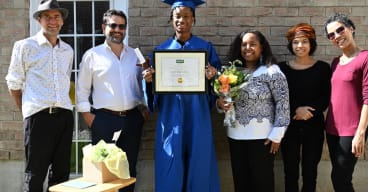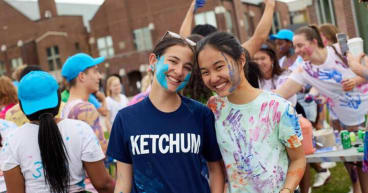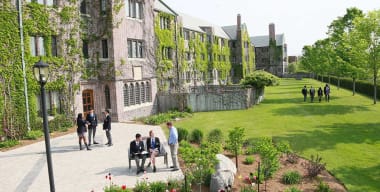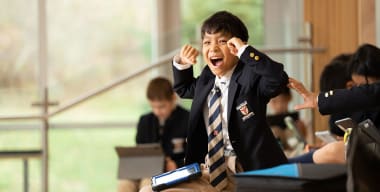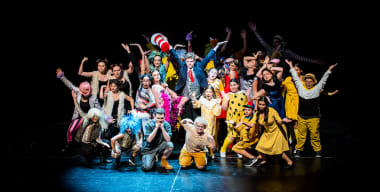From the 1,400-student campus of Town Centre Montessori Private School, in Markham, Ontario, to the 40 snow-loving athletes/students who attend Banff Mountain Academy, located within a national park just a couple of strides from a chairlift; from Winnipeg's two venerable and renowned schools - co-ed St. John's-Ravenscourt and Balmoral Hall for girls; to Calgary's 16-year-old Rundle College, where both the boys and the girls are rooting for female wrestling to become an Olympic sport, the good times are just beginning when the final school bell sounds.
"Our philosophy is, if we can find the coaching or the experts for an after-school activity, the kids can have it," says Dave Hauk, Rundle College's headmaster. His own interest and background in wrestling have certainly contributed to the 620-pupil school's passion for the sport. But noon-hour house programs in basketball and volleyball have existed since the school started. And the rugby program began last year thanks to popular demand: The kids asked for it.
"We've never held back when it comes to activities," Hauk says. But he checked out local schools before setting up the rugby program to ensure there was appropriate competition. "We want the activity to have some value. We're not setting the kids up for failure. We're not going in blind."
Even elementary-grade children take weekend outdoor education programs at Rundle, he says, and the Eclectic Arts Club is always out and about in Calgary, sampling and experiencing food, dress, and customs of different cultures. There's also a chess club, a band, a jazz band, and two dance groups.
One end of the high school's supersized gymnasium is now a 25-foot climbing wall, built by some teachers when students expressed an interest in the activity. "That's our bottom line - to find something to tap into for the kids not into anything," Hauk says.
It means that each member of his staff of 70—Rundle has a 12:1 student-to-teacher ratio - takes on three to six extracurricular activities and each student takes part in from six to 10 activities in a school year.
There's plenty going on at St. John's-Ravenscourt School in Winnipeg, as well, where an extraordinary legacy is in the making. For nine of the last 14 years, a St. John's student has won the World Individual Debating and Public Speaking championships, including the last four years.
Elliot Tapper, 17, is the latest winner, following up on Kris Ade's '99 triumph. Tapper has a "nice, witty style," while Ade was a "passionate" speaker, says John Robinson, who coached them both and, indeed, all of the school's teams and individual debaters for the past 19 years.
He facetiously credits "good prairie air" for the school's unequalled winning streak, but at St. John's public speaking is taught early - starting in Grade 1, followed by lessons in debating beginning in Grade 7. By the time students are in the senior school, half of them are involved in debating as an extracurricular activity.
"It gets them used to speaking in public, which is so often ignored in a lot of education," Robinson says.
And it eradicates the ubiquitous "um" along with "ah" and "like, you know." How? Robinson has class members clap each time an irritant is uttered. "It works because most people aren't aware of doing it and you can't get rid of it until you're conscious of it. And because students take their nervous energy and use it to focus on speech."
Like a fidgeter who has learned to sit still, there's a certain elegance to those who speak well and a calm emanating from mastering a skill used in everything from job interviews to business meetings to winning dinner-party arguments.
"Most surveys show that people's second greatest fear—after falling from a height—is speaking to a crowd," Robinson says. Except if you're from St. John's-Ravenscourt.
At Calgary's Webber Academy, much of the after-school talk is in Mandarin or Spanish—the two foreign languages taught there. School founder Earl Webber did his research and gleaned that these are the languages much of the world will be using in another decade or so.
And if anyone is going to be prepared for the future, the students at Webber Academy will be. Academically, they are among the top 25 percent of Calgary's school population; they're motivated and they're focused.
And well-rounded. Lunch-hour programs range from putting out a school newspaper to music to chess. So enthusiastic are the children, that the school has had to limit their lunchtime participation to two clubs per student.
"If it were left up to the children, they would over-subscribe to the clubs," Webber says.
They're even busier this fall, with the school's move to a new 47-acre campus, which has room for a soccer pitch, plenty of space for track and field training, and a place to play field hockey. The school now accommodates 400 students, an increase of 120.
"Track and field will be our Number 1 priority," Webber says. "Our students can participate from an early age to high school. Not many Canadian schools do this, but American schools do and we expect our children to get (sports) scholarships at American universities if they want them."
About 600 of the 1,400 students at Town Centre Montessori Private School, in Markham, just north of Toronto, Ontario, are involved in the 27 different extracurricular programs offered—often as many as three.
Not a bad percentage. But it's an extraordinary rate of involvement considering that the programs—their costs range from $10 to belong to the choir to more than $100 to take an art class or cartooning workshop involving materials - are available only to preschool and elementary students. Only 15 or so of the high-school students are involved—hired to help the younger students get to their activities.
This Montessori school provides—free—after-school homework tutorial sessions followed by arts and crafts programs up to 6:30 most evenings.
The demand for after-school programs—including sports, dance, piano, piano theory, sewing, and chess—adds up to 250 programming hours a week.
"It's wonderful," says Adrianna Mador, who until last year co-ordinated the after-school programs single-handedly. Now several people help figure out the logistics of 27 different programs. "The parents love it. They can pick up their kids and go home instead of being a chauffeur taking them to classes every night."
That means more quality time together. "I know some parents still take them to Brownies and things like that," Mador says. "But now they have two or three nights a week when they can be home together."
Students are escorted back to their classrooms after their activities, and the school stays open until 6:30 p.m. That means parents whose children stay late know they've had time to do homework at school. Instead of flying through dinner so the children can do their homework, all the parents need do is check the work, she adds. And the children don't mind the extra hours at school one bit. "They get to have an activity with their friends, and with teachers they already know," Mador says.
Vicky Jordan has been running the Junior School after-school program at Winnipeg's Balmoral Hall for 11 years. Some girls who were once kindergarten students in her program now are senior students working for her. There isn't a lot she needs to tell them. "Nobody knows it better than them," Jordan says.
Of course, the program has changed over the years - and there are always surprise activities and new themes to explore in the two-hour-a-day, five-day-a-week extended-day program. But its structured activities and consistent routines allow the young children in its care to feel safe because they know what to expect, Jordan says. The girls arrive during circle time, during which stories are read and songs are sung until everyone is present and accounted for. Weather permitting, the group - usually 25 to 30 strong, ranging from kindergarten to Grade 5 - goes outside for games and recreation, then everyone heads back into a classroom for a snack.
After that, it's a special activity. Just what that activity depends on the day of the week, but Jordan is adamant that if a student wants to do crafts, play by herself, or watch a video instead of the programmed activity, that's fine.
The program is open to all students in the junior school and no one needs to book in advance. "It gives parents incredible peace of mind," Jordan says. The children love the program; some cry because they don't want to go home. Many parents are greeted with wails and complaints of 'Why'd you come so early?' "In this program, we play, laugh, and learn," Jordan says. "It's definitely not just babysitting."
In many ways, there really is no such thing as an after-school activity program at Banff Mountain Academy. That's because it's held during school hours.
In fact, that's why this school for elite athletes situated on Banff National Park's Mount Norquay exists. The idea for it grew out of the Olympic Winter Games in Calgary in 1988 when geologist and school founder Don Findlay noted that the average age of the Canadian alpine ski racing team was 21 - but their average level of completed education was Grade 10.
"It struck him that these intelligent young people were paying a high academic cost to realize their athletic dream," says headmaster Ian Watt.
Findlay decided to find the right site for a school where motivated teachers could create flexible schedules to allow the athletes to hit the powder when not hitting the books—and he did.
The residence is in the town of Banff, but the school itself is on Mount Norquay. "I look out my office window and I'm 30 metres from a ski run," Watt says.
Or, as happened late last spring, he can look out his window and see a mama bear and her two cubs, which is why the school has broadened its mandate to include students with a passion for the outdoors, its ecology, history, and wildlife—"mountain living," as Watt calls it—and, most recently, snowboarding.
"I suspect there will be Olympic medallists in the next 10 years (in snowboarding) who will be from Banff Mountain Academy," Watt says.
He can say this for two reasons. One is the fact that the school attracts students with a passion for their sport—grads Carey Muller and Thomas Grandi are on Canada's national alpine team; student Cameron Barnes is on Canada's junior alpine team and Luke Patterson made the Alberta alpine team. Patterson spent most of last year's fall semester training and competing in Europe. When he returned, he worked independently over the Christmas break, followed by eight-to-10-hour days on his studies through January.
This leads to the second reason: The school runs on a semester system. Students take only three or four courses at a time and classes run from 8:30 a.m. to 4 p.m. That would be a long day if what other schools call outdoor education or after-school activities weren't worked right into the daily mix. At the academy, students spend a full morning two or three days a week being coached on the ski hills. Every snow day, they get at least 90 minutes there.
"We maximize snow time," Watt says. And they individualize study loads.
The result is that 90 percent of the students go on to post-secondary education. And some, like Jan Hudac, can decide to train full-time for two to four years to see if they can crack the upper echelons of competitive skiing - without giving up any other options to do it.

